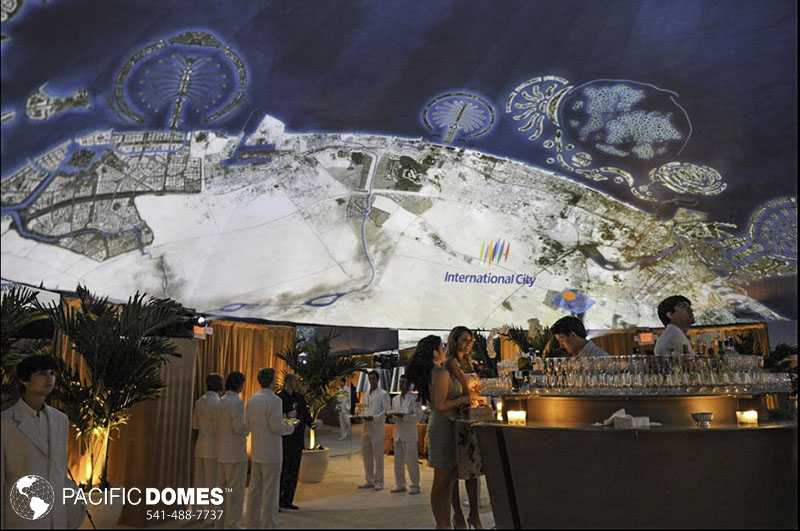The connection between the mind and physical health has been well documented and extensively studied. Innovation involves the therapeutic application of an immersive “virtual” environment, conjuring up pleasant, relaxing images that rest the mind and body. Pacific Domes has the means to make this happen.

Positive mental imagery can promote relaxation, reduce stress, improve mood, control high blood pressure, alleviate pain, boost the immune system, and even lower cholesterol and blood sugar levels. Use of guided imagery is a widely accepted practice among mental healthcare providers and is gaining acceptance as a powerful tool across a number of medical disciplines. With guided techniques, patients can learn to control functions normally controlled by the autonomic nervous system, such as heart rate, blood pressure, respiratory rate, and body temperature.
However, some individuals have difficulty imagining. They may not get actual clear images but only vague feelings about the guided journey. It would seem advantageous to take the guess work out and “transport” the patient directly into that healing, calming space with visual, and other direct sensory queues. This would serve to amplify the benefits of the therapist- guided session. Patients who feel uncomfortable “opening up” in a traditional therapist-patient session may feel more at ease with a virtual environment to assist the relaxation process.
Domes in use Technology for this purpose is already in existence, but the application of the “virtual vacation” has not yet been realized. The domes are portable and can withstand extreme weather conditions. They are easily erected, in most cases within a day or two, and would be appropriate wherever a 50 to 90 foot area is available. Cost of the projection technology remains prohibitive, however investments would eventually lower costs by moving beyond prototypes.
Endless possibilities of environments might include an orchid-laden natural garden, babbling brook in a pristine forest, white sand beach with an azure sea, or other beautiful settings. The images could move, as if one were walking, or could remain “stationary” once a person has settled into a “resting” position. Other components of the “illusion” might include aromatherapy, props such as plants, water sounds or sand underfoot.
Once under the immersive environment for an appropriate time, an audio component would direct the session, depending on the therapeutic goals. The session might last anywhere from forty-five minutes to an hour. Some types of therapy might include relaxation imagery, healing imagery, pain control imagery, and mental rehearsal. Other uses might be in addiction or other behavior modification.

Healing Imagery
Patients coping with diseases and injuries can imagine cancer cells dying, wound healing, and the body mending itself. Or, patients may picture themselves healthy, happy, and symptom-free. Another healing imagery technique is based on the idea of qi, or energy flow, an idea borrowed from traditional Chinese medicine. Chinese medicine practitioners believe that illness is the result of a blockage or slowing of energy flow in the body. Individuals may be guided to imagine energy moving freely throughout the body as a metaphor for good health.
Pain Control Imagery
Individuals can control pain through several imagery techniques. One method is to produce a mental image of the pain and then transform that image into something less frightening and more manageable. Another is to imagine the pain disappearing, and the patient as completely pain-free. Or, one may imagine the pain as something over which he has complete control. For example, patients with back problems may imagine their pain as a high voltage electric current and turning down the power on the current to alleviate the pain.
Mental Rehearsal
Mental rehearsal involves imagining a situation or scenario and its ideal outcome. It can be used to reduce anxiety about an upcoming situation, such as surgery, or even a critical life event such as an impending deployment into a war zone. Individuals picture themselves going through the anxiety-producing event and then successfully completing it.
Results of a study conducted at The Cleveland Clinic Foundation and published in 1999 found that cardiac surgery patients who used a guided imagery tape prior to surgery experienced less pain and anxiety. These patients also left the hospital earlier following surgery than patients who used pain medication only. Another study conducted by Harvard Medical School, researchers found that for more than 200 patients undergoing invasive vascular or renal surgery, guided imagery controlled pain and anxiety more effectively than medication alone.
Addiction and Behavior Modification
Use of guided imagery is a widely accepted practice among mental healthcare providers and is gaining acceptance as a powerful tool toward a range of therapeutic goals. Virtually-induced states of relaxation might be used to reduce symptoms of anxiety from drug withdrawals (perhaps reduce or eliminate the need of anti-anxiety medications, such as albuterol). Application of suggestion under induced relaxation might also be useful for weight loss, smoking cessation, or managing a variety of compulsive behaviours.
